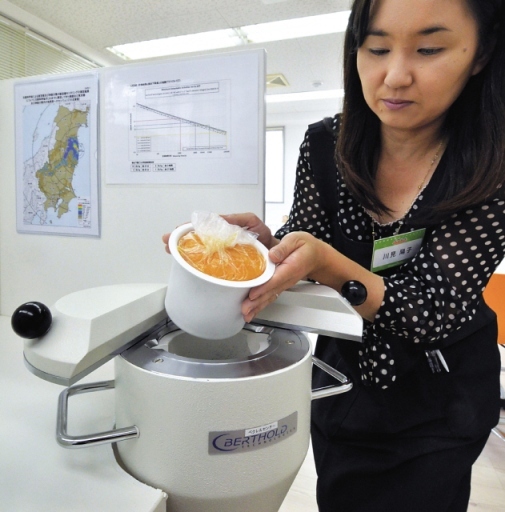TOKYO (AFP) ― Mayumi Kurasawa’s seaweed company saw seven of its factories swept away by Japan’s 2011 tsunami. Nearly two years later, sales continue to be eroded by consumer fears over nuclear contamination.
“Our seaweed is checked every day, and I guarantee you that it’s safe,” she told AFP during a recent visit to Tokyo to promote the company she works for, Kawashu. “But we are selling two-thirds less than before Fukushima.”
Like many farmers in the Tohoku region in northeast Japan, Kurasawa is struggling to sell her produce to a wary population that remains unconvinced by reassurances of food safety.
The problem is the Fukushima Daiichi nuclear plant in the region’s south, where reactors went into meltdown after cooling systems were swamped by the March 11, 2011 tsunami.
 |
An employee of the Becquerel Center, a firm that rents machines that check for radiation levels, demonstrates how to use a scintillator to measure radiation levels of a sample of mashed persimmon at their shop called Bekumiru in Kashiwa, suburban Tokyo, on Oct. 21, 2011. (AFP-Yonhap News) |
The reactors spewed radioactive contamination into the atmosphere, forcing the evacuation of tens of thousands of people.
Despite the Kawashu company’s production sites being 300 kilometers away from the nuclear plant, in Iwate Prefecture, it is struggling to sell its “wakame” seaweed.
“Many clients prefer produce from South Korea or from China over us. They think it’s safer,” said Kurasawa.
Previously lauded for their quality, Tohuku products from wasabi, mushrooms, fruit and cereals to salmon and sake (rice wine) are now regarded with suspicion by many Japanese customers as a consequence of Fukushima.
Sales for Tohoku’s products have dropped 60 to 70 percent on average against pre-accident levels.
In the aftermath of the disaster, the legal limit for radioactive caesium in Japanese foods was raised in line with international emergency procedures before returning to normal in April last year.
This return to “normal” should have reassured consumers, but the stigma has lingered from temporary bans imposed on beef, milk, mushrooms, vegetables and rice from Fukushima prefecture after they were found to contain levels of radioactive caesium above government safety limits.
Faith eroded
Public faith that certain foods were safe has also been hit by instances of fraud, in which wholesalers have attempted to sell Fukushima produce under the labels of other regions.
The products in question were found to not be dangerous, but the deception, along with doubts over government food screening measures cobbled together in the wake of the accident, has made life even harder for farmers.
Consumers and experts have also voiced suspicions that officials understated potential health risks due to worries about potential economic fallout and the complications of possible compensation.
Food shops, skeptical about the government’s legal limit of 100 becquerels of radioactive caesium per kilogramme for food, have begun their own testing regimens.
The country’s largest supermarket chain, Aeon, has been enforcing zero-risk policy.
“If we detect radioactive caesium in a product over measurable limits, we stop procuring it from the area it is produced,” Aeon spokesman Norihito Ikkai told AFP. “As a result, it enables customers to buy our products free from anxiety.”
In the area around the power-station, the majority of produce is now well below the legal limit for radiation and most produce, plants and animals raised in other prefectures of Tohuku, pass inspections.
“All products sold here are checked and healthy,” said Katsuyasu Ito, the chef of French restaurant “L’aur?ole” in Oshu, Iwate Prefecture. “But anxieties remain among consumers when it comes to Tohoku products.”
Economic consequences
Exports have also been hit, falling 8.3 percent from 2010 to 451.1 billion yen in 2011, according to statistics from the agriculture, forestry and fishery ministry.
“A total of 45 countries and areas restricted food imports from Japan following the nuclear plant accident, resulting in declines in shipments,” a ministry official said. “Generally, they are easing the curbs except for South Korea.”
In the town of Soma, 40 kilometers from the Fukushima Daiichi power plant, locally grown rice is often up to scratch but only locals want to buy it.
Masahiro Saito, a chicken farmer who has seen a 20 percent loss in his turnover, feels less unlucky than his cereal and vegetable-growing neighbors, some of whom have had to pack up for good.
“At the peak of the radiation in March 2011, I recorded 5 becquerels of radioactive caesium per kilogram on my chickens,” said Saito ― well below the government limit.
Like most of his counterparts, he has raised his animals on American corn, which explains why he and other farmers have suffered less than others in the region.
But the consequences of the nuclear accident are still being felt two years later on on the overall economy, not just agriculture, and on the daily lives of hundreds of thousands of people in the region.
The clean-up around Fukushima is expected to take decades and experts warn that some settlements may have to be abandoned.
Anecdotally, the pressures are mounting and stories of people whose livelihoods have dried up abound in the Japanese press.
The Cabinet Office says up until last November 76 people in the region took their own lives in connection with the disaster.
Of the deaths, 21 were linked to financial and livelihood issues and nine to employment issues, the government said.








